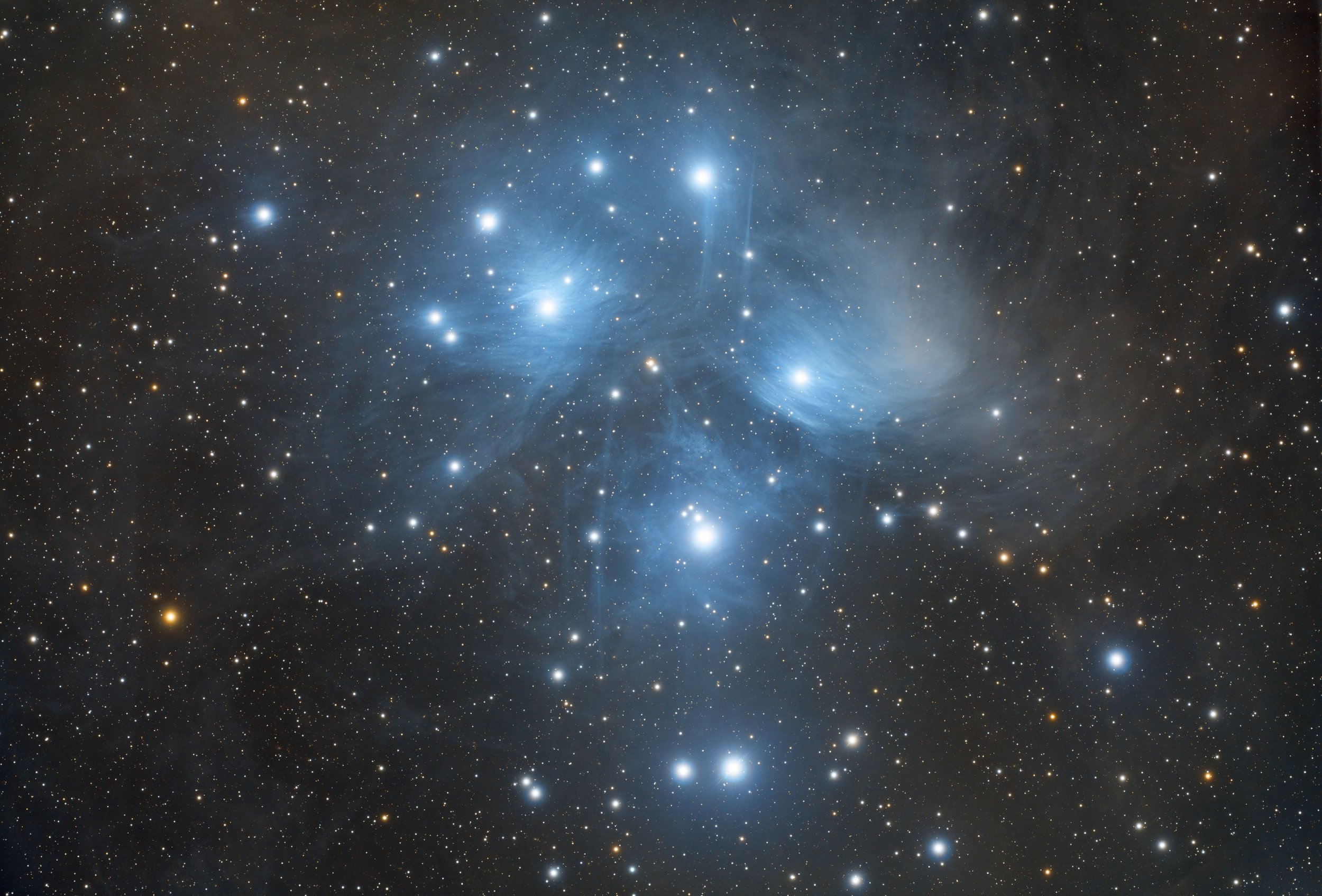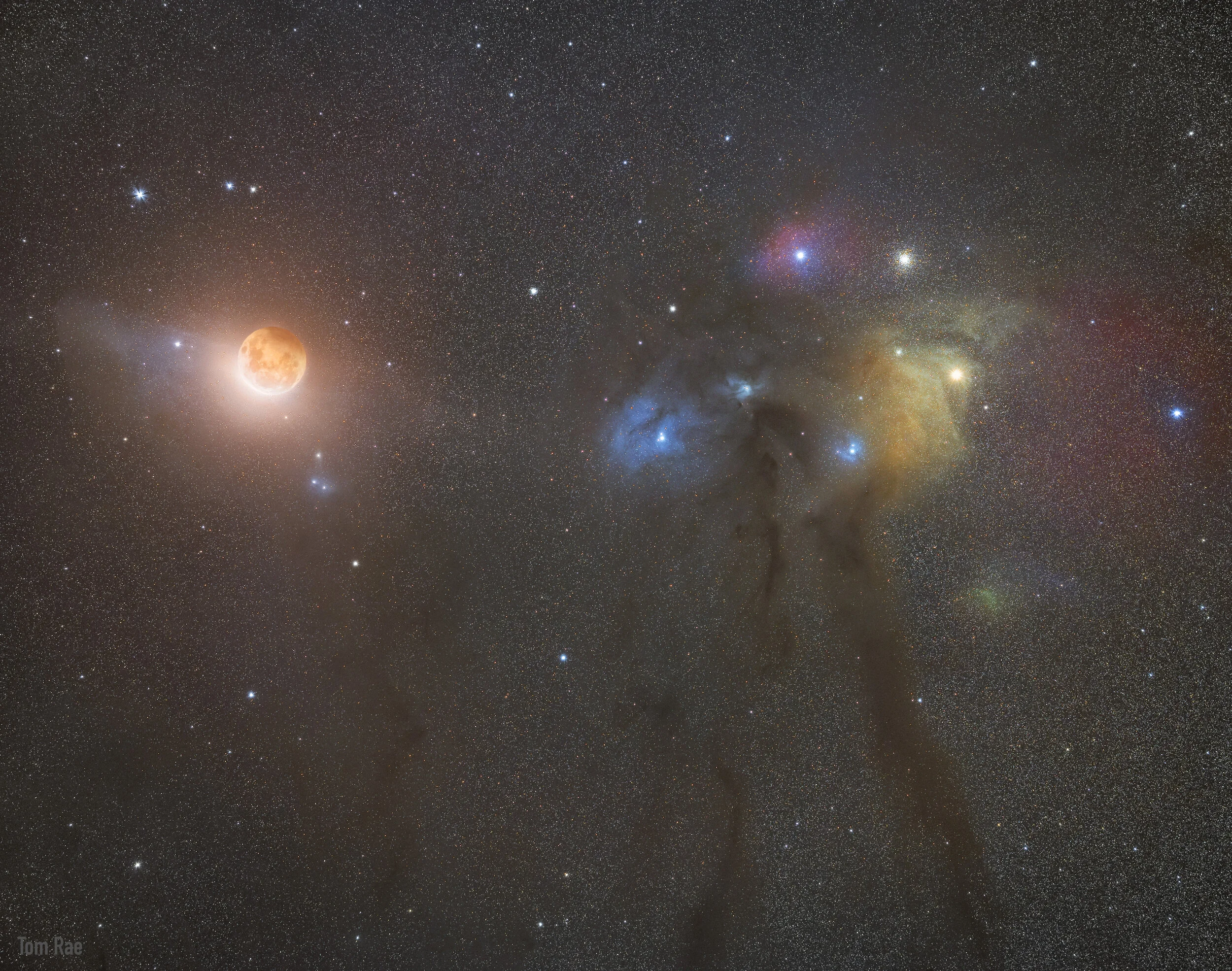
AAPOD2 Image Archives
WR 134 - V1769 Cyg
This colorful shot covers a field of view about the size of the full Moon within the boundaries of the constellation Cygnus. It highlights the bright edge of a ring-like nebula traced by the glow of ionized hydrogen and oxygen gas. Embedded in the region's interstellar clouds of gas and dust, the complex, glowing arcs are sections of bubbles or shells of material swept up by the wind from Wolf-Rayet star WR 134, brightest star near the center of the frame. Distance estimates put WR 134 about 6,000 light-years away. Shedding their outer envelopes in powerful stellar winds, massive Wolf-Rayet stars have burned through their nuclear fuel at a prodigious rate and end this final phase of massive star evolution in a spectacular supernova explosion. The stellar winds and final supernovae enrich the interstellar material with heavy elements to be incorporated in future generations of stars.
Tech card:
Imaging telescope: Explore Scientific 127mm ED TRIPLET APO.
Imaging camera: ZWO ASI1600MM Pro-Cool.
Mount: iOptron CEM60.
Guiding camera: ZWO ASI290MM mini.
Focal reducer: Explore Scientific 0.7 Reducer/Flattener.
Accessory: ZWO EAF Electronic Auto Focuser · ZWO ASIAIR Pro · ZWO OAG · ZWO 8x 1.25" Filter Wheel (EFW).
Frames:
Chroma 3nm Ha: 10x600" (gain: 200.00) -20C bin 1x1.
Chroma 3nm OIII: 22x600" (gain: 200.00) -20C bin 1x1.
Total integration: 5.3 hours.
Darks: ~30.
Flats: ~30.
Flat darks: ~60.
Avg. Moon age: 18.13 days.
Avg. Moon phase: 87.56%
Bortle Dark-Sky Scale: 4.00.
Temperature: 20.00.
Pixel scale: 1.159 arcsec/pixel.
Imaging location: Abu Dhabi desert, UAE.
A re-process of my data of Dec. 3 and 4, 2020.
I tried to boost the OIII channel and tried to pull out some more details.
Copyright: Wissam Ayoub
Purgathofer-Weinberger 1
Purgathofer-Weinberger 1, PuWe1 ( PN G 158.9 + 17.8 ) is a large, circular planetary nebula in the constellation of Lynx.
PuWe1 was discovered by Alois Purgathofer and Ronald Weinberger in 1980 on the Palomar Deep Sky Survey prints. The nebula is one of the largest planetary nebulae visible in our skies, with a diameter of 20 arc minutes. PuWe1 is also one of the nearest known planetaries with a distance of only about 1200 light years.
This image taken over several nights in March-April 2021.
R-channel - 30 x 150 sec. bin 1x1;
G-channel - 30 x 150 sec. bin 1x1;
B-channel - 30 x 150 sec. bin 1x1;
Ha- 88 x 600 sec. bin 2x2;
OIII- 40 x 600 sec. bin 2x2.
Total integration time about 25:05 hours.
My setup: Telescope 8" Celestron Schmidt-Cassegrain (SCT) CPC800 GPS (XLT) on the equatorial wedge, focal reducer Starizona Night Owl 0.4х, Feq=864mm, camera Starlight Xpress Trius SX694, SX mini filter wheel, filters Astrodon LRGB E-series gen.2, Astrodon Ha 5nm, Astrodon OIII 3nm.
Capture and processing software: MaxIm DL6, PHD2, PixInsight, StarTools, Photoshop CC, Zoner photo studio 14.
North at the top.
Copyright: Boris Vladimirovich
Tulip nebula & Cygnus X-1 black hole jet
Image Description and Details :
Next to the tulip nebula is black hole Cygnus X-1. This is the first X-ray source discovered in Cygnus and the first black hole ever confirmed. The blue star HD 226868 revolves around this black hole in 5.5 days.
The black hole draws in gas from this star. The gas that piles up in the accretion disk around the black hole becomes so hot that it emits X-rays. In addition, the infalling gas also forms a jet.
This jet collides with the interstellar gas. The shock wave that this forms can be seen in this image.
Details:
telescope: Skywatcher 150/750PDS
mount: Skywatgcher HEQ5
camera: QHY 294M
filter: Astronomik 12nm Ha
74 x 6 minutes (7.4 hours) over 2 nights
40x flat and darkflat frames
30x dark frames
image aquisition: NINA
processing: Pixinsight.
Copyright: Remco Kemperman
Rho Ophiuchi and The Eclipse
Image Description and Details :
All of the data acquired to produce this image was shot during the Lunar eclipse's totality. The image was shot on the east coastline of New Zealand (Bortle 2) on the 26th of May 2021. This eclipse was special, not only because it occurred during a supermoon, but also because of its positioning in the night sky. Gear includes: Nikon Z6 and Rokinon 135mm F2, mounted on an iOptron Skyguider Pro. Exposure settings: Rho Ophiuchi - 16 x 30s, ISO 1600, F2.8. Lunar Surface: 1/5th of a second, ISO 1600, F2.8.
Copyright: Tom Rae
A bubble in Hercules, Abell 39
Image Description and Details :
Abell 39 is a faint nearly symmetrical planetary nebula in Hercules. Exposures for Abell 39 taken from 3 April to 21 May 2021 from my backyard Observatory. 32.1 hrs of exposure time consisting of 160min of Red and Green, 140min of Blue, 700min of Ha and 760min of OIII. I used my Stellarvue SVX 152T with a ZWO ASI 6200 camera. Control was with Voyager automation. The images were taken using 1x1 binning for a resolution of .64 arcsec/pixel. The exposures were also done using a 1/2 frame ROI.
Abell 39 is the 39th entry into George Abell's catalog of planetary nebula. Within this field are an enormous amount of background galaxies, probably more than foreground stars. The image is a crop of a much larger field of view.
Copyright: Jon Talbot
Sh2 155 "Cave" Nebula
Image Description and Details : Sh2-155 or Sharpless 155 is a diffuse nebula in the constellation Cepheus, within a larger nebula complex containing emission, reflection, and dark nebulosity. Images showing a curved arc of emission nebulosity corresponding to a cave mouth (roughly center of image) gives rise to the popular moniker "Cave Nebula". Sh2-155 is an ionized H II region with ongoing star formation activity, at an estimated distance of 2400 light-years from Earth.
Capture info:
Location: Orion’s Belt Remote Observatory, Mayhill NM, USA
Telescope: Takahashi 180ED reflector
Mount: Paramount MX+
Camera: SBIG STXL 16200
Data: 4.75,4.25,4,4.75,4.5 hours LRGB , Ha respectively
Processing: Pixinsight
Copyright: David Doctor
Solar System 2020
This is a collage of solar system objects Left to right: Mercury, Venus(in a very thin crescent phase), International Space Station, Mars, Jupiter, Saturn, Uranus, Wanning gibbous Moon on the top(19-panel mosaic), and Sun at the bottom(4-panel mosaic) all Captured in 2020 using Different equipment.
Equipment:
Telescopes: GSO 16" Dob on EQ platform, EdgeHD11", Esprit 80mmAPO
Cameras: ZWO462MC, ZWO 290MC, ZWO1600mmpro.
Accessories: ZWO UV/IR Cut filter, IR 685nm filter, ZWO ADC, Daystar quark Chromosphere, Tilt adaptor.
Software: Autostakkert!3, Registax, Photoshop
Location: Sharjah, UAE
Date: Jan - Dec 2020
Copyright: Prabhu S Kutti










